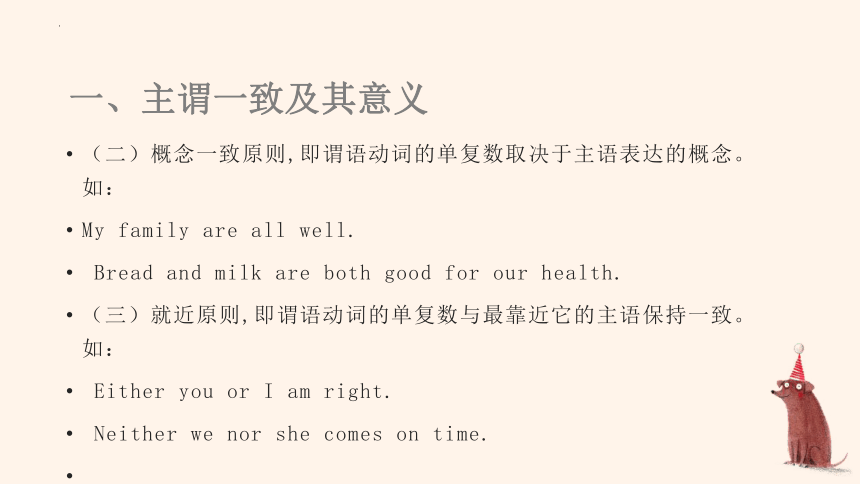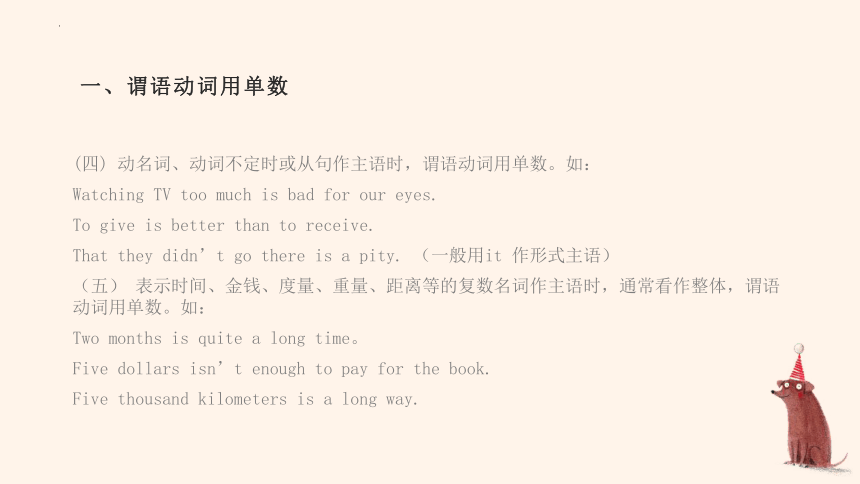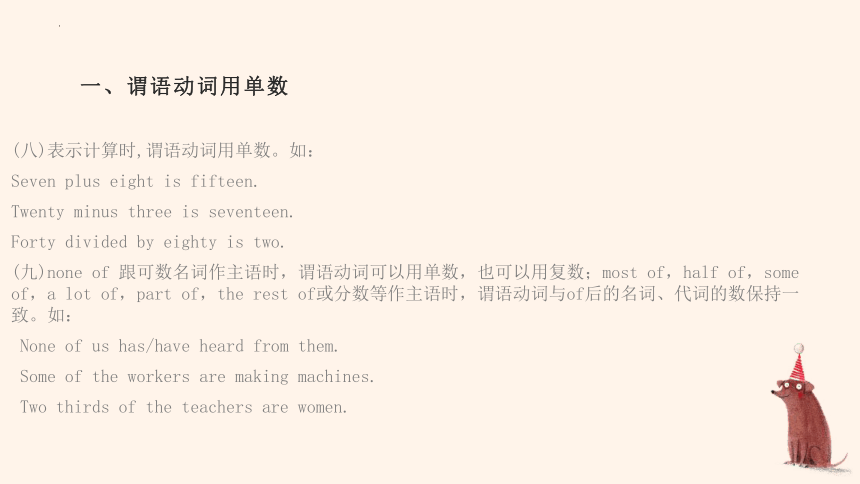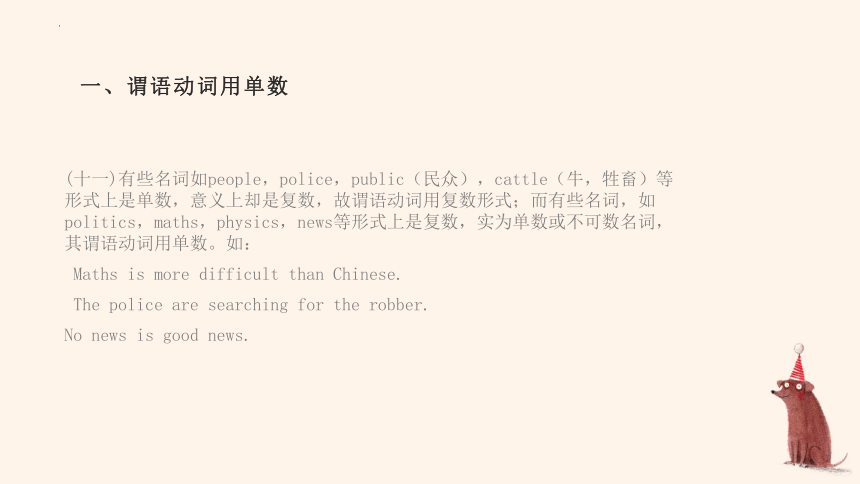2024届高三英语一轮复习主谓一致课件(共19张PPT)
文档属性
| 名称 | 2024届高三英语一轮复习主谓一致课件(共19张PPT) |  | |
| 格式 | pptx | ||
| 文件大小 | 2.0MB | ||
| 资源类型 | 教案 | ||
| 版本资源 | 通用版 | ||
| 科目 | 英语 | ||
| 更新时间 | 2024-02-24 02:05:56 | ||
图片预览







文档简介
(共19张PPT)
主谓一致
一、主谓一致及其意义
英语句子的主要组成部分是主语和谓语, 其中谓语动词是其核心。谓语动词在人称和数上要跟主语保持一致, 即主谓一致。主谓一致一般遵循以下三个原则:
(一)语法一致原则,即谓语动词同主语在单复数形式上保持一致。如:
She is a clever girl.
We come from Dongying.
He goes to school on foot every day.
一、主谓一致及其意义
(二)概念一致原则,即谓语动词的单复数取决于主语表达的概念。如:
My family are all well.
Bread and milk are both good for our health.
(三)就近原则,即谓语动词的单复数与最靠近它的主语保持一致。如:
Either you or I am right.
Neither we nor she comes on time.
(四) 动名词、动词不定时或从句作主语时,谓语动词用单数。如:
Watching TV too much is bad for our eyes.
To give is better than to receive.
That they didn’t go there is a pity. (一般用it 作形式主语)
(五) 表示时间、金钱、度量、重量、距离等的复数名词作主语时,通常看作整体,谓语动词用单数。如:
Two months is quite a long time。
Five dollars isn’t enough to pay for the book.
Five thousand kilometers is a long way.
一、谓语动词用单数
(六) 用and 连接的并列主语表示不同的人或物时,谓语动词用复数; 表示同一人、物或概念时,谓语动词用单数。如:
Jim and Lily have visited the Great Wall of China.
My classmate and friend lives in Shandong province.
The speaker and writer is going to give us a talk tomorrow.
A fork and knife is on the table.
(七)用and 连接的单数主语前有each,every,no等修饰时,谓语动词用单数。如:
Each student and each teacher is going to see the film.
No food and no water is in the house.
一、谓语动词用单数
(八)表示计算时,谓语动词用单数。如:
Seven plus eight is fifteen.
Twenty minus three is seventeen.
Forty divided by eighty is two.
(九)none of 跟可数名词作主语时,谓语动词可以用单数,也可以用复数;most of,half of,some of,a lot of,part of,the rest of或分数等作主语时,谓语动词与of后的名词、代词的数保持一致。如:
None of us has/have heard from them.
Some of the workers are making machines.
Two thirds of the teachers are women.
一、谓语动词用单数
(十一)有些名词如people,police,public(民众),cattle(牛,牲畜)等形式上是单数,意义上却是复数,故谓语动词用复数形式;而有些名词,如politics,maths,physics,news等形式上是复数,实为单数或不可数名词,其谓语动词用单数。如:
Maths is more difficult than Chinese.
The police are searching for the robber.
No news is good news.
一、谓语动词用单数
(十二)主语后跟有with,together with,but,except,as well as等词或短语时,谓语动词与前面的主语保持一致。如:
Nobody but the twins knows it.
The mother with her two children is playing.
She as well as I is a woman teacher.
(十三)“a number of+复数名词”作主语,谓语动词用复数;“the number of+复数名词”作主语,谓语动词用单数。如:
A number of students are playing basketball on the playground.
The number of the boys is 30.
一、谓语动词用单数
1.谓语动词用单数
动词不定式、动名词、从句、不定代词/由some, any, no, every构成的复合代词(anything, ether, no one, neither等)
The number of +名词复数
one and a half +复数名词
第三人称单数,不可数名词(如:money, information等)
(十四)trousers, shoes, glasses, gloves, clothes等做主语时,谓语动词用复数; 但如果其前面有a /this pair of, a suit of, pairs/suits of 等量词,则往往跟pair等的数一致。如:
This pair of glasses is Kate’s.
My shoes are under the bed.
Some pairs of trousers have been sold out.
(十五)有些形容词,如old,young,poor,rich,dead,strong等,在前面加定冠词表示一类人时,谓语动词用复数。如:
The old are taken good care of here.
The rich should help the poor all the time.
一、谓语动词用复数
(十六)trousers, shoes, glasses, gloves, clothes等做主语时,谓语动词用复数; 但如果其前面有a /this pair of, a suit of, pairs/suits of 等量词,则往往跟pair等的数一致。如:
This pair of glasses is Kate’s.
My shoes are under the bed.
Some pairs of trousers have been sold out.
(十七)有些形容词,如old,young,poor,rich,dead,strong等,在前面加定冠词表示一类人时,谓语动词用复数。如:
The old are taken good care of here.
The rich should help the poor all the time.
一、谓语动词用复数
2.谓语动词用复数
由and和both…and连接的两个名词作主语,不论名词是可数/不可数
成对的名词(如:trousers, shoes, socks, glasses等)
several, both, few, many等
a number of +名词复数
语法一致
(十八)由并列连词either…or…, neither…nor…, not only…but also…, not…but…等连接两个主语时,谓语动词采取与就近的主语相一致的原则。如:
Either you or he is right.
Not only we but also she likes English.
Not you but I have been there.
(十九)There be 句型中谓语动词与离它最近的名词或代词在人称和数方面保持一致。如:
There is a boy and some girls over there.
=There’re some girls and a boy over there.
一、谓语动词用单、复数
(二十) 单复数相同的词如:sheep,Chinese,deer,fish,Japanese等作主语时,谓语动词要看具体情况决定用单数或复数。如:
Many Chinese are watching the match.
There is a little sheep on the hill.
一、谓语动词用单、复数
3.谓语动词用单/复数
A lot of, lots of, plenty of, most of +名词,谓语动词取决于of后的名词
例:A lot of people like to go to the park.
分数、百分数作主语,谓语动词取决于of后的名词
例:Twenty percent of the students are from China.
Two thirds of the water is from sea.
All单独做主语(表人时,谓语动词用复数;表物时,谓语动词用单数)
例:All are going to have a rest.
All is well that ends well.结果好,一切都好。
语法一致
谓语动词用单数
谓语动词用复数
时间, 金钱, 长度, 重量, 体积, 距离作主语
and连接的两个主语表示同一概念
例:The singer and dancer is my brother.
主语表示事务的总称且无生命(如clothing, fruit等)
表示事务的总称且有生命(people,police)
The + 姓氏复数,表示一家人(The Smiths, The Blacks等)
The +形容词,表示一类人
(the rich-富人们;the old-老人们)
意义一致
集合名词:family, team, class, company, government, group等
表示整体概念,谓语动词用单数
My family is a one with four people.
表示集体中的成员。谓语动词用复数
My family all like to read books.
单数/复数
就
近
原
则
either…or… 或者…或者…
not…but… 不是…而是…
not only…but also…不仅…而且…
there be … 有…
neither…nor…既不…也不…
就近原则——谓语动词与靠近它的主语保持一致
Thank you!
主谓一致
一、主谓一致及其意义
英语句子的主要组成部分是主语和谓语, 其中谓语动词是其核心。谓语动词在人称和数上要跟主语保持一致, 即主谓一致。主谓一致一般遵循以下三个原则:
(一)语法一致原则,即谓语动词同主语在单复数形式上保持一致。如:
She is a clever girl.
We come from Dongying.
He goes to school on foot every day.
一、主谓一致及其意义
(二)概念一致原则,即谓语动词的单复数取决于主语表达的概念。如:
My family are all well.
Bread and milk are both good for our health.
(三)就近原则,即谓语动词的单复数与最靠近它的主语保持一致。如:
Either you or I am right.
Neither we nor she comes on time.
(四) 动名词、动词不定时或从句作主语时,谓语动词用单数。如:
Watching TV too much is bad for our eyes.
To give is better than to receive.
That they didn’t go there is a pity. (一般用it 作形式主语)
(五) 表示时间、金钱、度量、重量、距离等的复数名词作主语时,通常看作整体,谓语动词用单数。如:
Two months is quite a long time。
Five dollars isn’t enough to pay for the book.
Five thousand kilometers is a long way.
一、谓语动词用单数
(六) 用and 连接的并列主语表示不同的人或物时,谓语动词用复数; 表示同一人、物或概念时,谓语动词用单数。如:
Jim and Lily have visited the Great Wall of China.
My classmate and friend lives in Shandong province.
The speaker and writer is going to give us a talk tomorrow.
A fork and knife is on the table.
(七)用and 连接的单数主语前有each,every,no等修饰时,谓语动词用单数。如:
Each student and each teacher is going to see the film.
No food and no water is in the house.
一、谓语动词用单数
(八)表示计算时,谓语动词用单数。如:
Seven plus eight is fifteen.
Twenty minus three is seventeen.
Forty divided by eighty is two.
(九)none of 跟可数名词作主语时,谓语动词可以用单数,也可以用复数;most of,half of,some of,a lot of,part of,the rest of或分数等作主语时,谓语动词与of后的名词、代词的数保持一致。如:
None of us has/have heard from them.
Some of the workers are making machines.
Two thirds of the teachers are women.
一、谓语动词用单数
(十一)有些名词如people,police,public(民众),cattle(牛,牲畜)等形式上是单数,意义上却是复数,故谓语动词用复数形式;而有些名词,如politics,maths,physics,news等形式上是复数,实为单数或不可数名词,其谓语动词用单数。如:
Maths is more difficult than Chinese.
The police are searching for the robber.
No news is good news.
一、谓语动词用单数
(十二)主语后跟有with,together with,but,except,as well as等词或短语时,谓语动词与前面的主语保持一致。如:
Nobody but the twins knows it.
The mother with her two children is playing.
She as well as I is a woman teacher.
(十三)“a number of+复数名词”作主语,谓语动词用复数;“the number of+复数名词”作主语,谓语动词用单数。如:
A number of students are playing basketball on the playground.
The number of the boys is 30.
一、谓语动词用单数
1.谓语动词用单数
动词不定式、动名词、从句、不定代词/由some, any, no, every构成的复合代词(anything, ether, no one, neither等)
The number of +名词复数
one and a half +复数名词
第三人称单数,不可数名词(如:money, information等)
(十四)trousers, shoes, glasses, gloves, clothes等做主语时,谓语动词用复数; 但如果其前面有a /this pair of, a suit of, pairs/suits of 等量词,则往往跟pair等的数一致。如:
This pair of glasses is Kate’s.
My shoes are under the bed.
Some pairs of trousers have been sold out.
(十五)有些形容词,如old,young,poor,rich,dead,strong等,在前面加定冠词表示一类人时,谓语动词用复数。如:
The old are taken good care of here.
The rich should help the poor all the time.
一、谓语动词用复数
(十六)trousers, shoes, glasses, gloves, clothes等做主语时,谓语动词用复数; 但如果其前面有a /this pair of, a suit of, pairs/suits of 等量词,则往往跟pair等的数一致。如:
This pair of glasses is Kate’s.
My shoes are under the bed.
Some pairs of trousers have been sold out.
(十七)有些形容词,如old,young,poor,rich,dead,strong等,在前面加定冠词表示一类人时,谓语动词用复数。如:
The old are taken good care of here.
The rich should help the poor all the time.
一、谓语动词用复数
2.谓语动词用复数
由and和both…and连接的两个名词作主语,不论名词是可数/不可数
成对的名词(如:trousers, shoes, socks, glasses等)
several, both, few, many等
a number of +名词复数
语法一致
(十八)由并列连词either…or…, neither…nor…, not only…but also…, not…but…等连接两个主语时,谓语动词采取与就近的主语相一致的原则。如:
Either you or he is right.
Not only we but also she likes English.
Not you but I have been there.
(十九)There be 句型中谓语动词与离它最近的名词或代词在人称和数方面保持一致。如:
There is a boy and some girls over there.
=There’re some girls and a boy over there.
一、谓语动词用单、复数
(二十) 单复数相同的词如:sheep,Chinese,deer,fish,Japanese等作主语时,谓语动词要看具体情况决定用单数或复数。如:
Many Chinese are watching the match.
There is a little sheep on the hill.
一、谓语动词用单、复数
3.谓语动词用单/复数
A lot of, lots of, plenty of, most of +名词,谓语动词取决于of后的名词
例:A lot of people like to go to the park.
分数、百分数作主语,谓语动词取决于of后的名词
例:Twenty percent of the students are from China.
Two thirds of the water is from sea.
All单独做主语(表人时,谓语动词用复数;表物时,谓语动词用单数)
例:All are going to have a rest.
All is well that ends well.结果好,一切都好。
语法一致
谓语动词用单数
谓语动词用复数
时间, 金钱, 长度, 重量, 体积, 距离作主语
and连接的两个主语表示同一概念
例:The singer and dancer is my brother.
主语表示事务的总称且无生命(如clothing, fruit等)
表示事务的总称且有生命(people,police)
The + 姓氏复数,表示一家人(The Smiths, The Blacks等)
The +形容词,表示一类人
(the rich-富人们;the old-老人们)
意义一致
集合名词:family, team, class, company, government, group等
表示整体概念,谓语动词用单数
My family is a one with four people.
表示集体中的成员。谓语动词用复数
My family all like to read books.
单数/复数
就
近
原
则
either…or… 或者…或者…
not…but… 不是…而是…
not only…but also…不仅…而且…
there be … 有…
neither…nor…既不…也不…
就近原则——谓语动词与靠近它的主语保持一致
Thank you!
